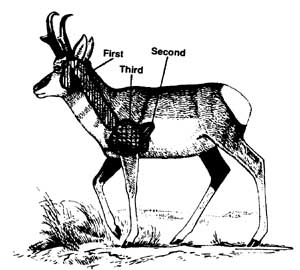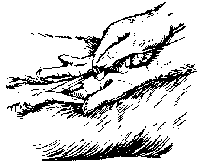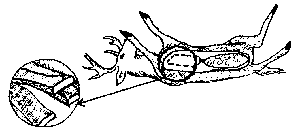by D.E. Benson 1 (6/2010)
Quick Facts…
- Kill a game animal instantly, preferably with a shot to the heart and lungs or neck area.
- Eviscerate soon after the kill. After evisceration, clean and wipe the body cavity and hang the carcass in the shade to cool.
- When transporting a carcass, keep the meat as clean and cool as possible.
- Aging a carcass makes the meat more tender.
Big game hunting can be a source of top quality meat. Virtually all of the so-called “wild” or “gamey” taste in big game is because of poor processing by the hunter, not the intrinsic quality of the meat.
While processing big game in the field, it is impossible to duplicate exactly the procedure used by commercial slaughter houses. However, enough poor practices can be eliminated to make the difference negligible.
While you hunt, carry a knife with a 5- to 6-inch blade, 15 feet of nylon rope for dragging or hanging the animal, a plastic bag for the heart and liver, and about 2 feet of string for tying the animal’s anus and esophagus.
If the animal is skinned in the field, carry enough cheese cloth or old sheets to cover the carcass. A meat saw or hatchet is desirable for cutting out the breast and pelvic bones in large animals.
 |
| Figure 1: Preferred shot placement. |
Killing
Kill the animal instantly. Perhaps the best locations are a well-placed head or neck shot, but the heart and lung region is generally recommended (Figure 1).
If the head is saved for mounting or the head-neck region are hidden, place the shot in the heart-lung area just behind the front shoulder. Stay close to the shoulder and avoid the gut region. The animal can escape with a shot in the gut and will probably die days later.
Hitting the middle of the shoulder is just as deadly, although more meat is ruined by the bullet. If these areas cannot be hit, don’t shoot.
Practice before the beginning of each big game season to make sure the rifles function properly. Sights and scopes can easily be jarred out of alignment and should be checked before each hunt.
Hunters should not take long or difficult shots. The best hunters try to stalk within easy range of the quarry and kill the animal instantly.
Some hunters say that the animal’s scent or musk glands should be removed soon after death because they can taint the meat if left on. These glands are made conspicuous by the long tufts of hair surrounding their opening.
Most big game animals have the scent glands; one pair on the inside hind leg at the hock (tarsal gland) and one pair in the outside lower hind leg (metatarsal glands). The glands excrete a penetrating odor or musk. Males frequently urinate on these glands during the breeding season. Therefore, avoid touching exposed meat if you touch these areas. Leave the glands on and skin them off as you skin the entire hide. There is no danger of meat contamination by leaving scent glands. They are fully contained in the skin and have only one opening to the outside.
If an animal is hit in the heart or lung region by a modern rifle bullet, it normally bleeds internally. Opening the carcass and eviscerating it will get rid of the blood. If the shot was to the head or neck, cut the animal’s main arteries and veins at the base of the neck. If in doubt whether to bleed or not, bleed the animal.
If the head is to be mounted, bleed the animal by entering through the rib cage and severing the large veins and arteries connected to the heart.
 |
| Figure 2: Cutting. |
Eviscerating
Eviscerate the animal as soon after the kill as possible. Immediately after death, gas resulting from microbial action will accumulate in the rumen. The longer the wait, the more difficult the animal is to gut and the less desirable it is for human consumption. Also, the animal begins to cool quickly.
To eviscerate the animal, cut through the hide from the anus to the head. Begin between the legs by cutting down through the leg muscles to the skin over the pelvic bone. Turn the knife over and cut through the skin over the abdomen by using two fingers from the other hand to hold the viscera (intestines and stomach) away from the tip of the knife (Figure 2).
Cut up through the breastbone and up the neck as far as possible. Note: if the head is to be mounted, stop the cut between the legs at the base of the brisket. It is easier, especially on larger animals, such as elk, to cut on either side of the breastbone or brisket (through the joints) as shown in Figure 3, rather than up the middle.
Be sure to leave evidence of sex (either half of the mammary gland or a testicle) attached to the carcass to comply with state law.
Sever the windpipe and esophagus as close to the head as possible. Tie a string tightly around the esophagus to keep contents from contaminating the meat. Cut around the anus and tie it with a string for the same reason. Next, cut the thin diaphragm muscle that separates the heart-lung compartment from the main digestive tract away from the ribs (see Figure 4).
 |
 |
| Figure 3: Cut on both sides of the brisket (not up the center). | Figure 4: Diaphragm. |
This is a good time to remove the heart and liver. They are excellent eating and should be kept in a plastic bag to keep them clean.
Lay the animal on its side. The contents should either fall out or pull out easily. A few cuts close to the backbone may be necessary to separate attached organs.
Hang the animal in the shade to drain the blood from the body cavity and to circulate air around the body to cool it. Hang with head or hind legs up. In the absence of a tree, fence or other object to hang the carcass on, place logs or stones under it to keep it off the ground to allow heat to escape. In either case, prop the body cavity open with a stick or two and wipe the body cavity clean. If the body cavity is accidentally soiled from digestive tract contents, wash it out with clean water. Do not use water to wash the body cavity after the cavity is dried and sealed.
Skinning
In most cases, when a big game carcass is dragged to camp or transported in a vehicle, leave the skin on to keep the meat clean. Also, leave the hide attached to prevent the outer layer of meat from becoming dry during the aging process.
In warm weather, it is best to take the carcass to a cooler the day of the kill. If this is not possible, transport the carcass to camp or home. If the nighttime temperature is expected to be above freezing, skin the carcass.
If skinning is necessary, cover the carcass with an old sheet or cheesecloth to protect it from insects and dirt. Sprinkle black pepper on exposed meat to help keep flies away.
Whether the carcass is skinned while it is hanging from its hind legs or head, or while it is on the ground, leave as much fat and connective tissue as possible with the carcass and keep the carcass free from hair and dirt.
Transportation
Transporting a big game carcass for a few hours is seldom a problem. Keep the carcass as clean and cool as possible. For longer trips or in warm weather, place bags of dry ice in and around the carcass to keep it cool. For trips several hundred miles, or temperatures consistently above 70 degrees F, butcher and freeze the carcass, pack it in dry ice and drive to the destination. Do not use dry ice if flying; it is not allowed.
Aging
The purpose of aging is to make meat more tender. If the entire carcass is to be processed into ground meat or stewing meat, there is no need to age it. Do not age the carcass longer than necessary, however, to eliminate excess carcass shrinkage and bacteria growth. The following aging recommendations are at 40 degrees: antelope, 3 days; deer, 7 days; cow elk, 7 days; bull elk, 14 days. No research data are available to make specific recommendations for other big game species, although it seems logical that periods of one to two weeks would be acceptable.
Temperatures warmer than 40 degrees will shorten the recommended aging period. If the carcass is exposed to 60 or 70 degrees during the day, butcher and freeze in a few days. Always age a carcass in the shade. If the hide is removed, reduce the aging time to avoid drying out the carcass.
After aging, the carcass is ready for butchering and the freezer.
1Colorado State University Extension wildlife specialist and professor, fishery and wildlife biology. 11/98. Reviewed (6/2010).
Go to top of this page.





